24 Facts About Chile Food, Drinks, and Chilean Food Culture

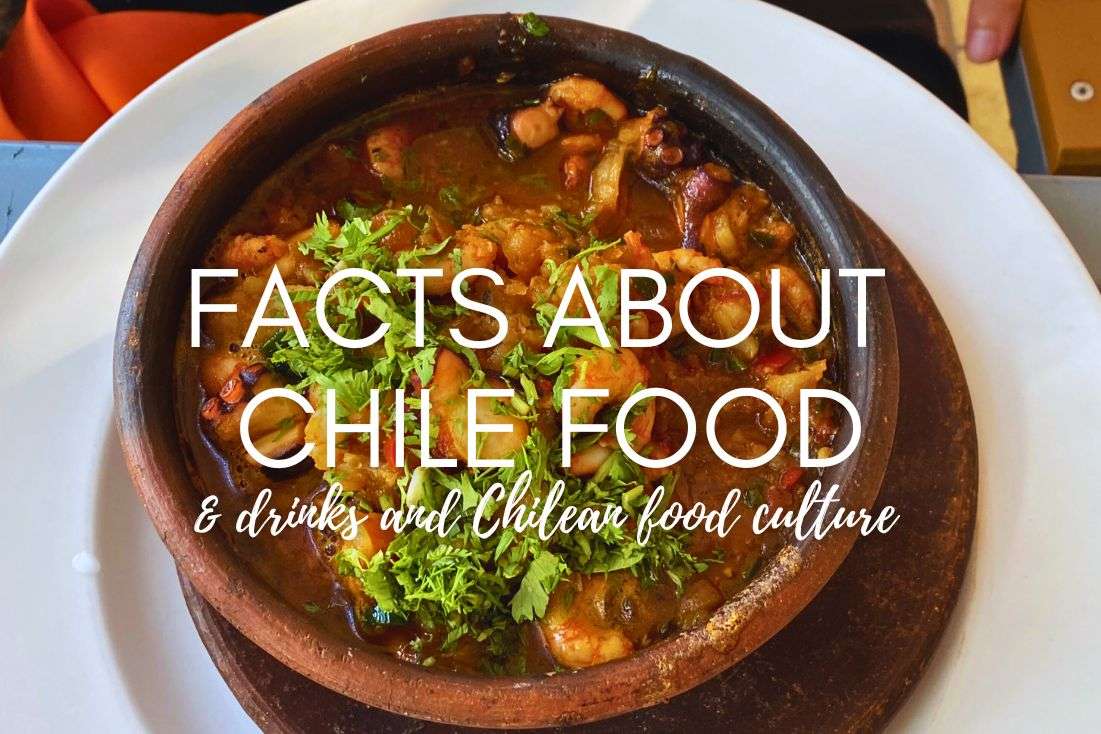
I consider Chile’s food the best cuisine outside of the EU! The food in Chile is like a wild ride through flavors. From indigenous traditions to European influences, Chilean cuisine is rich and diverse, offering something for every palate. If you thought Chile was one of those South American countries where Hispanic dishes take the lead, think again.
For example, I had one of the best Italian meals ever in Santiago, and just a couple of minutes from that Italian restaurant, I could’ve bought a traditional German meal with a delicious cold beer. What more could you wish for?
Trust me, when you’re traveling for several weeks through one country, the variety in Chile’s cuisine will keep your taste buds excited, just like its landscapes. (Learn more about Chile, possibly my favorite country in South America.)
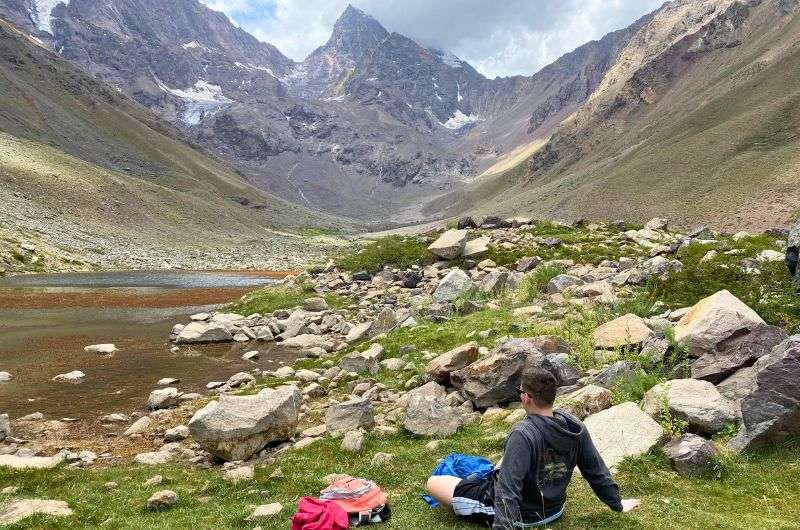
Chilean cuisine is as diverse as its landscape
In this article, I’ll talk about the food culture, Chilean recipes, give you a list of the best street food and traditional dishes (some of which sounds very experimental!), and then talk a little but about Chile’s drinks. Spoiler: This is one country where I actually liked the beer!
What is a fun fact about Chilean food?
First and foremost, Chile is the second-longest country in the world. Why am I telling you this? It’s because this fact greatly impacts Chilean cuisine. With the crazy range of climates, soils, and ecosystems, Chile is a flavor playground. You can find everything from tropical fruits in the north to rich seafood from Patagonia’s icy waters.
My verdict: Chile’s cuisine is outstanding!
For me, travel in South America is always a dilemma when it comes to how long I want to spend there. Why? The lack of food variety! But Chilean cuisine is the silver lining for us folks who sometimes find Hispanic food a bit underwhelming. There’s so much to choose from.

All the amazing hikes, views, attractions and more will certainly make you hungry
If you don’t have weeks to spend traveling around Chile and you want to eat well while there, head to the Lake District. This region has some of the best food, from traditional Mapuche meals to irresistible chocolate treats for sweet tooths like me.

Sometimes, all you need to do is take the first step... I've filtered out the best hotels in Chile for you
Save it for yourself to come back to later, or share with your friends on social media!
I've already planned your ititnerary for the trip, complete with my travel tips.
My top tips for enjoying Chile’s food and drinks:
- Plan around mealtimes: Lunch is the main event in Chilean food culture, typically served from 1–3 pm. It's a social affair, so don’t expect quick service during these hours.
- Ask for the bill at restaurants: If you’re eating at a restaurant, you need to ask for your bill when you’re done eating. Otherwise, they’d let you sit there until closing time for fear of being rude. This is one thing that I prefer doing the American way, where they hit you with the bill the moment you swallow your last mouthful.
- Foodie neighborhood alert: Santiago is the go-to place for foodies. There is a small neighborhood called Barrio Italia which is like a smorgasbord of international restaurants.
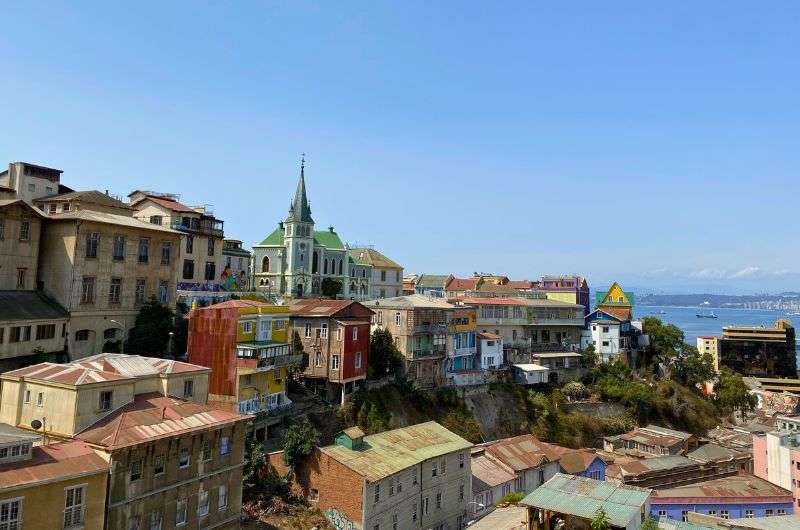
I don't even mind a good street food
- Explore street food: Chile’s street food, like sopaipillas and empanadas, is everywhere and offers a quick, affordable way to taste traditional flavors without committing to a long restaurant meal.
- Don’t worry, it’s safe! I ate tons of street food... seriously, a lot. And I had zero stomach troubles during my travels in Peru.
- Be adventurous with drinks: Pair your meals with Chile’s iconic beverages, like pisco sour or chicha. If wine is more your style, try a bold Carmenere or a crisp Sauvignon Blanc from local vineyards. I’ll have a beer though, please! (Beer is good in Chile!)
- See if your hotel does early breakfast: In popular hiking areas, like Patagonia, check if your hotel caters to hikers with extra-early breakfast times (or if they can pack a snack for you to go). Hotel Vendaval, where I stayed in Torres del Paine, did great and had eggs ready at 6 am sharp! Lovely little hotel, by the way.
Chilean food facts: Get to know Chilean food culture
Before you do something that is considered unacceptable and offend someone in Chile with your behavior at meal time, let’s look at some fun facts about Chilean food culture.
1. Chilean cuisine is meant to be shared with friends and family
Sharing meals with friends and family is an important aspect of Chilean food culture. Lunch is often considered the main meal of the day and is typically enjoyed with family members or colleagues. It's a time for socializing and connecting with loved ones.

The main meal is lunch, which is the best to eat with family or friends
2. Mealtimes in Chile: Lunch is the main meal
Breakfast in Chile is usually a light meal and often consists of bread, cheese, ham, avocado, and coffee or tea.
Lunch is the main meal of the day, that is typically served between 1:00 pm and 3:00 pm. It often includes multiple courses, such as soup, a main course, and then dessert.
Dinner is generally a lighter meal and is eaten late in the evening, usually between 8:00 pm and 10:00 pm.
3. Cuisine plays a key role during traditional Chilean food festivals and celebrations
Chile hosts various food festivals and celebrations that highlight the diversity of its cuisine. These events often bring people together to enjoy local dishes, street food, and traditional recipes from different regions of the country.
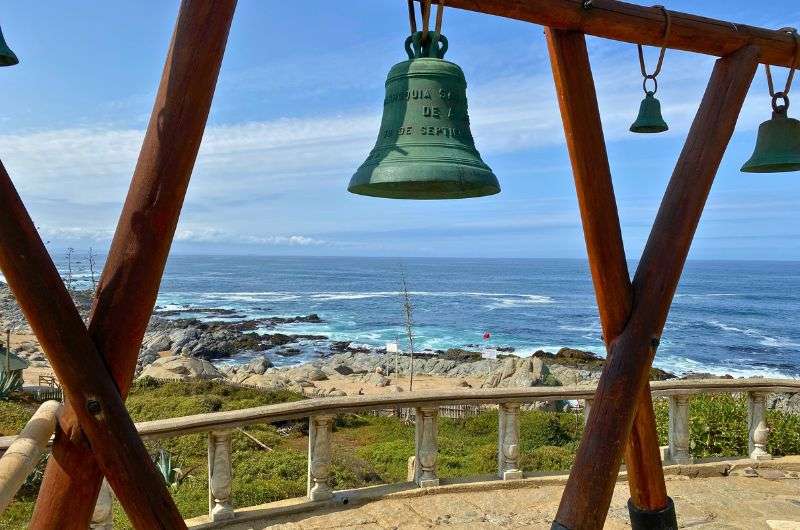
How about planning a trip to Chile during Fiestas Patrias?
The biggest national festival is called Fiestas Patrias, during which Chile celebrates its independence and cultural heritage. The festival takes place on September 18 and 19. Most schools and businesses are closed at that time, and everybody celebrates with a lot of dancing, eating and drinking. It involves a lot of traditional Chilean foods including empanadas and a lot of barbecued meat so if you’re in Chile in September, make sure to stay long enough to join the celebrations.
4. Street food is on every corner in Chile
Chile’s street food provides travelers with an easy and affordable way to eat during their adventures—like when you don’t want to spend a couple of hours in a restaurant.
One of the most typical foods in Chile is the so-called comida tipica, which is the style of eating of the working class. It might not blow your taste buds away with fancy twists, but trust me, it’s budget-friendly, and it hits the spot from time to time. You’ll find little stands serving common foods in the streets all around the country.
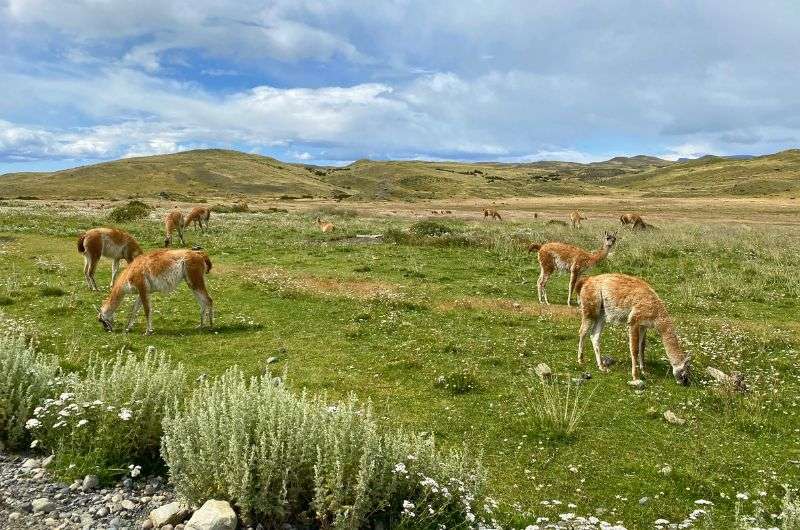
In Chile, there is food at every turn. For all species
5. What NOT to do while eating in Chile?
- Do NOT hide your hands: Putting your hands under the table while eating is considered rude in Chile, so be so kind and leave your hands on the table at all times—none of that sneaky lap business, okay?
- DON’T be on time: When invited to a meal, it is expected that you’ll arrive 15 minutes later than the scheduled time. It's the polite thing to do—not to catch the host off guard.
- DON’T eat with your hands: Always use utensils. Eating with your hands is considered rude. Chileans are big on manners!
- Do NOT use your left hand to pour wine. Chileans are very proud of their wine traditions, so of course there is a rule about wine pouring. You’re supposed to pour wine only with your right hand. Pouring wine with your left hand means that you don’t like the person whose glass you’re filling up.

You're glad you're not gonna embarrass yourself visiting Chilean restaurants thanks to me, aren't you?
- Do NOT sip before they say cheers! And here's the golden rule of drinking in Chile: hold off on the sips until someone busts out a toast… but I hope that’s just common sense. Cheers to keeping it classy!

The best street food in Chile: staples of Chilean gastronomy
Street food is very popular in Chile, offering a wide range of affordable and delicious options, though mostly deep-fried. From traditional snacks to more exotic choices, street vendors play a significant role in Chilean food culture.
Pro tip: Mote con huesillo, a sweet drink made with dried peaches and wheat, is a typical Chilean street food companion, especially during the summer months.
6. Empanadas: a savory pastry filled with flavor
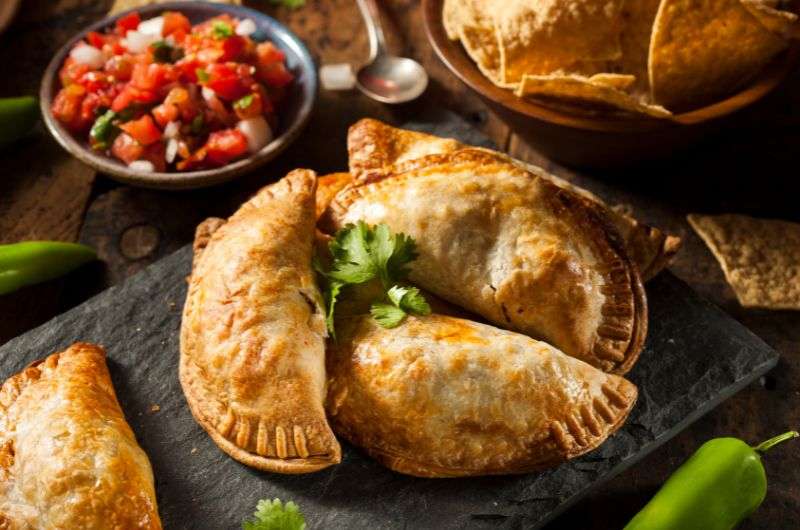
Empanadas
As the most traditional food in Chile, empanadas must be at the top of the street food list. I mean, who doesn’t love pastries? Sweet or salty, whoever came up with the first empanadas recipe deserves a medal!
Empanadas are such a treat and come in so many variations that you could eat a different kind of empanada for a month and still have plenty left to try. They look so simple, and yet, when you bite into one, it is like an explosion of different flavors.
The traditional empanada is called pino, made of ground beef, onions, a hard boiled egg, and sometimes olives and raisins. As I said though, Chileans can put anything in their empanadas: cheese, mashed potatoes, fish, veggies, fruits, you name it. So, try as many as you can!
7. Completo: an over-stuffed hot dog
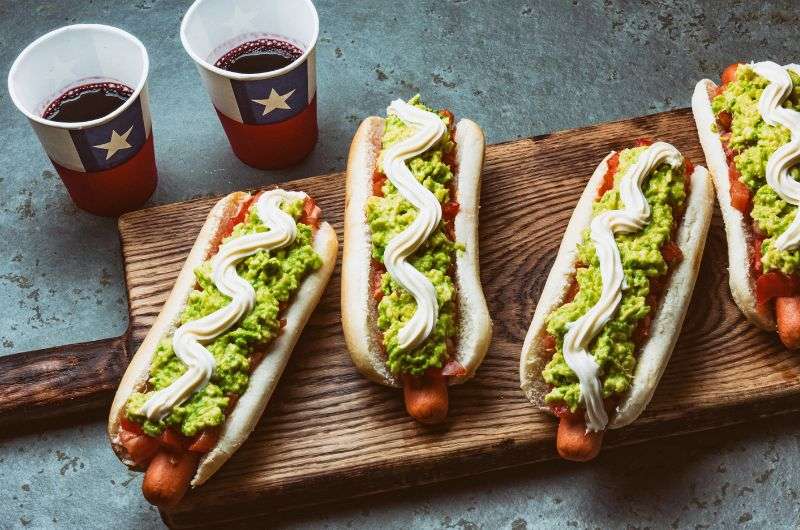
Completo—Chilean hot dogs
The completo is a Chilean-style hotdog mixed with any other foreign influence you can possibly think of.
Imagine a heavy-loaded hotdog bun with sausage, fresh tomatoes, mashed avocado, sauerkraut, mustard, and enormous amounts of mayonnaise. I know it sounds a bit too much, am I right? Though, try it after a beer tasting night and suddenly you get it. It is nasty, it is dirty, it is GOOD!
8. Sopaipillas: fried pumpkin dough disks
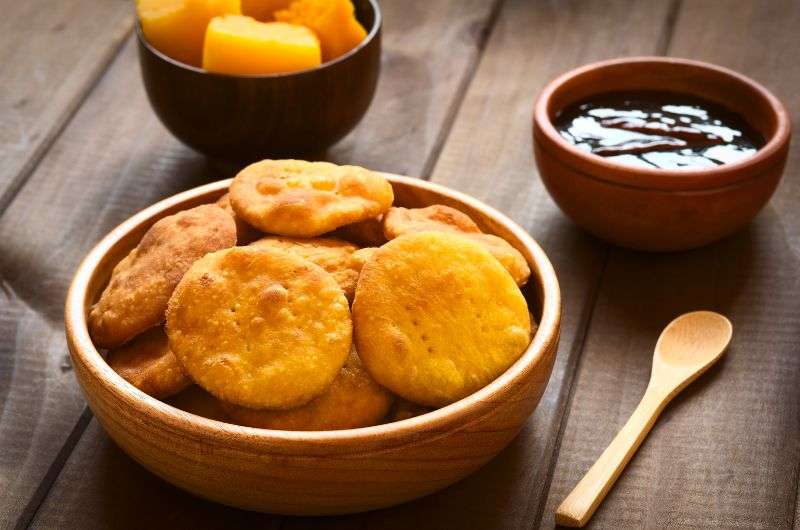
Sopaipillas
Sopaipillas are a Chile food made from pumpkin and flour and fried into a thin round bread. You can either dip them in syrup and powdered sugar, or you can eat them with mustard, cheese, and/or salsa.
Yes, they can be sweet OR savory! They make for a great snack when you’re out and about and are very popular among locals.
Seafood in Chile: these traditional dishes are anything but ordinary

Seafood is also typical for Chile
Chile has an extensive coastline, providing one of the best seafood (or, as they like to call it—frutas del mar) selections I have ever encountered.
Chile has cultivated a strong seafood culinary heritage that emphasizes the freshness of its seafood. Thanks to the coast reaching from the super cold waters of Patagonia all the way to the warmer currents of northern Chile, the Chilean seafood selection ranges from various kinds of fish through clams, sea urchins, and squids, all the way to the gigantic king crab.
Trust me, If you’re traveling to Chile, you’ll definitely try some sea creatures you’ve never eaten before. On top of that, the combinations they come up with are just mouth-watering!
9. Centolla: the freshest king crab
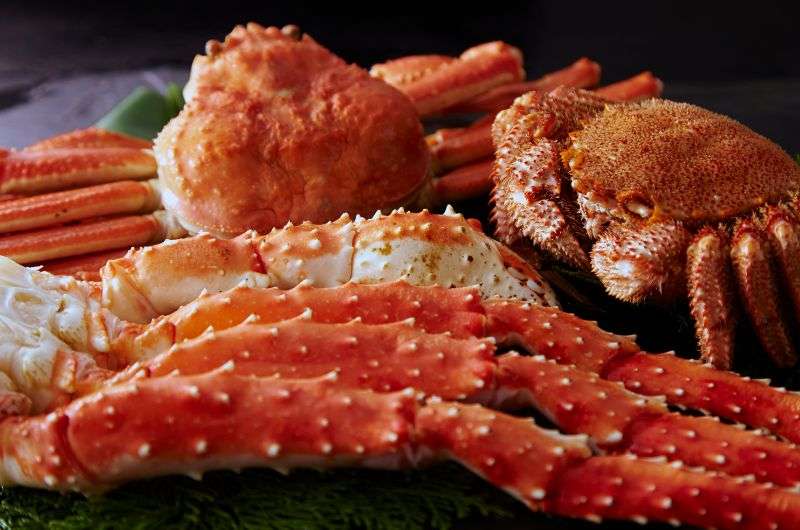
Centolla
There aren’t that many countries in the world that get to serve the freshest king crab, so you definitely need to try it when you’re eating out in Chile.
I tried king crab in Sotito’s restaurant, located in Punta Arenas. The crab was DELISH, but pro tip: skip the mayo and ask for butter, as it pairs much nicer with the meat.
Chuppe de centola, otherwise known as a crab dip, makes for a great appetizer. They have plenty of other dishes with crab meat, like crab pie, so it’s just up to you what you prefer.
10. Machas a la parmesana: baked razor clams with cheese
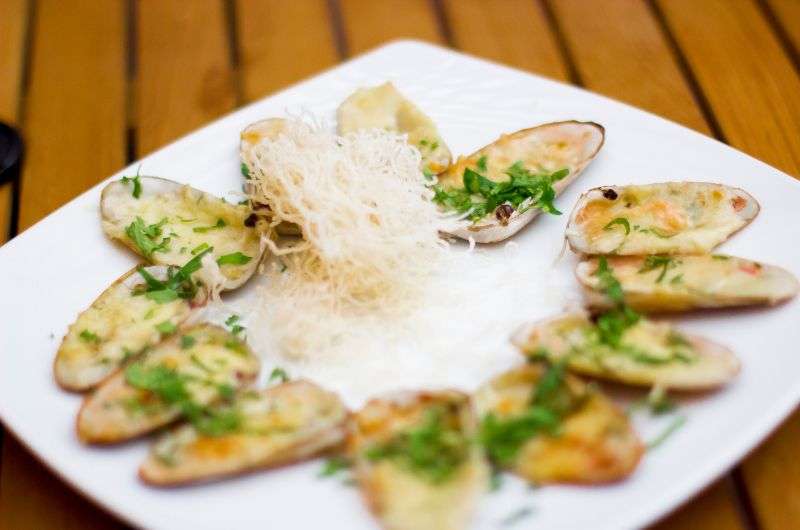
Machas a la parmesana
Another interesting Chilean cuisine contender is Machas a la parmesana, razor clams with butter, wine, and a parmesan crust on top. Add a salad to it, and you have a main course. Machas a la parmesana pair best with a crisp white wine, like Sauvignon Blanc.
11. Pastel de jaiba: Crab pie that’ll make you cry (with joy)!
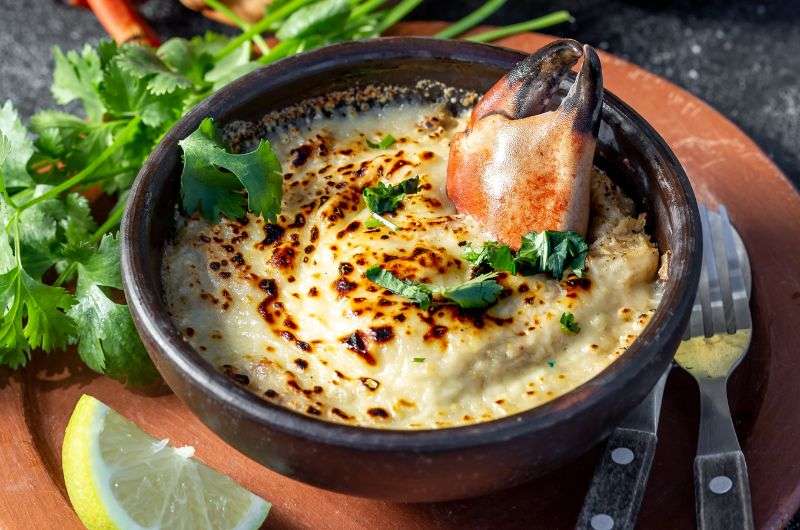
Pastel de Jaiba
This casserole style dish is made out of crab meat, various spices, and veggies. But most importantly, a lot of butter and cream blend the casserole into a perfect mixture of flavors that fills you up real quick. Don’t be shy, though, pig out as much as you can, even if this is the only meal you’ll eat today. It´s worth it!
12. Caldillo de congrio: a fish stew poem in a bowl
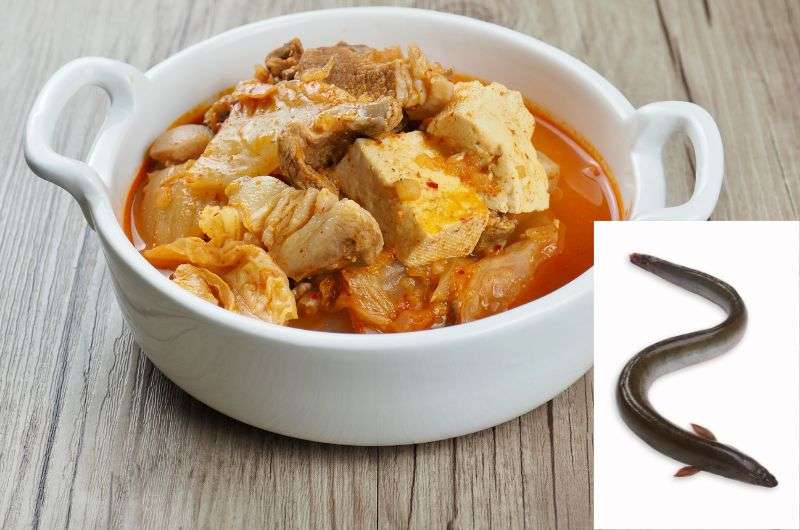
Caldillo de congrio
This seafood soup is probably one of the very few that has its own ode written to it, and rightfully so. It is made from eel meat, veggies, and some restaurants add cream to it, so it can get heavy. Serve it alongside a plate of french fries, and you’ve got yourself a very hearty meal.
Pablo Neruda dedicated one of his odes to caldillo de congrio soup. The ode is basically a recipe for the soup, but of course it has a double meaning, so if you’re into literature, get into the reading and find the underlining purpose of the ode. I’ll just keep eating this delicious Chilean food in the meantime.
13. Empanadas de mariscos: when empanadas and seafood collide
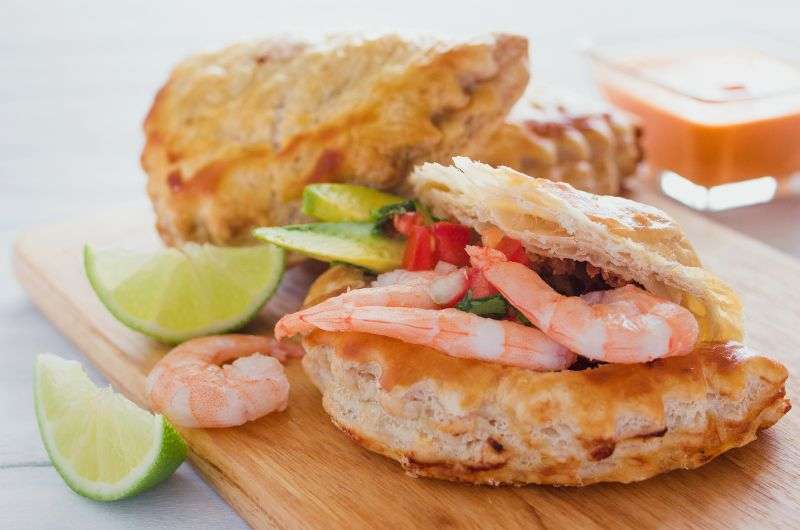
Empanadas de mariscos
It wouldn’t be a full list of the best Chile food without the seafood empanadas.
Chileans stuff empanadas with just any kind of fish, shrimp, crab, or other sea creature, add herbs, spices, and veggies and turn the pastries into a yummy piece of heaven. Try it baked, try it fried, it doesn’t matter, both will be equally delicious, best served with pebre—a traditional Chilean salsa.
My favorite Chile food: Chilean cuisine you have to taste!
There are several dishes that you need to try when you’re visiting Chile. Some of them are on the following list only because they’re not very common elsewhere. These might be meals that might not be on everyone’s “top Chile food” list, but you should try them a chance at least once. Others are just fantastic and must definitely be tried, no matter what.
14. Cordero al palo: an impaled lamb
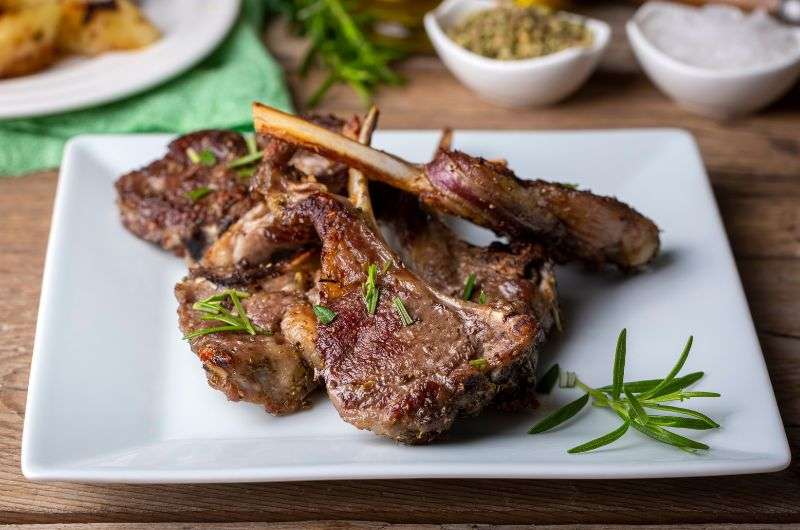
Cordero al palo
Cordero al palo, otherwise known as the spit-roasted lamb, this meal is prepared the old-school way. They take the lamb, split it wide open, and let it sizzle away on a metal rack right next to a roaring fire.
Now, I ain’t gonna lie, it might look a bit gruesome, kind of like that scene from the Vikings show with the blood eagle thing. But guess what? It’s all about the experience, and the lamb meat is on point.
As the meat is slowly roasted by the flames, all that juiciness stays right where it should—locked inside. That means you’re getting some seriously tender goodness after it’s been grooving on the fire for a solid 5 hours. After that, they slap on some pebre salsa for that extra zing and pair it with Malbec, the red wine. It’s a match made in Chilean foodie heaven, amigos.
15. Curanto: a smoky pit of seafood and meat delight
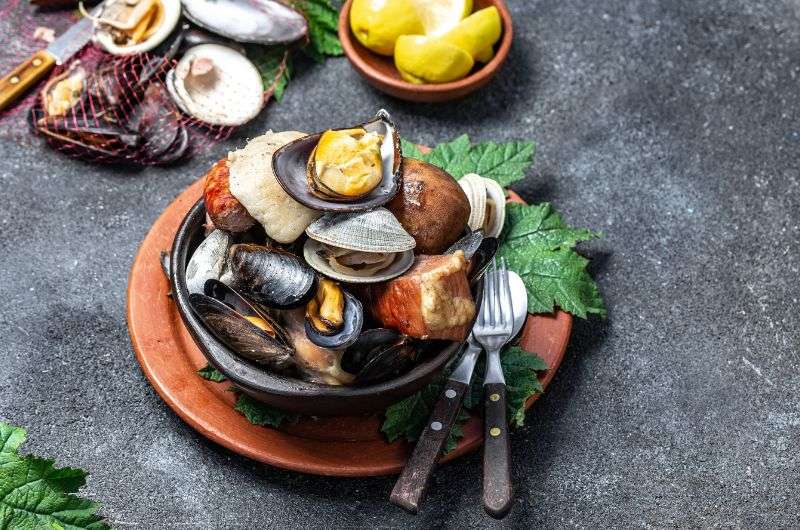
Curanto
The origins of this traditional Chilean food lie with the indigenous Mapuche people, so if you’re exploring the southern parts of Chile, especially Chiloé Island, this is an absolute must-try.
Curanto is a hearty combo of meat and seafood, but the twist is that it’s not whipped up in the kitchen. Nope, this creation comes to life in an earthen pit filled with piping hot stones.
Once those rocks are blazing red, they’re layered with all the curanto ingredients—meats, sausages, mussels, clams, potatoes, and veggies all bundled up with oversized Chilean rhubarb leaves.
And then, it’s all about the steam show, cooked to perfection by the shellfish and meats’ natural juices for hours. Grab a glass of red wine and enjoy this ultimate Chilean delicacy!
16. Erizos del mar: who doesn’t love a nice sea urchin straight from the ocean?
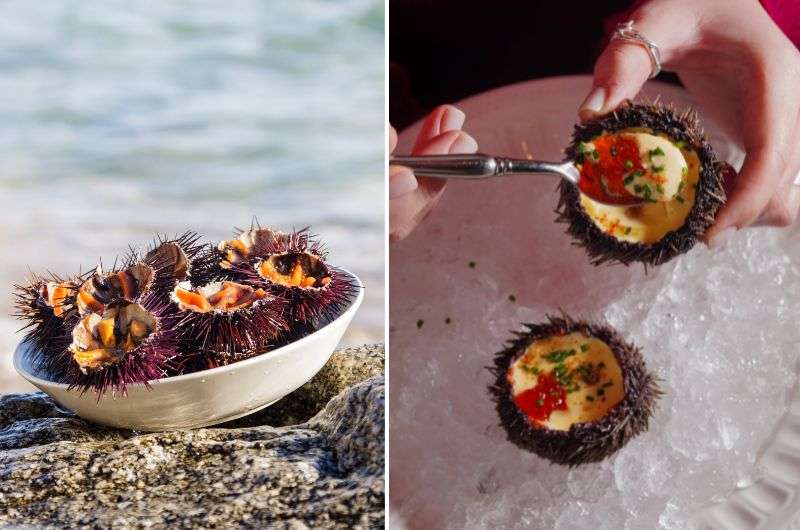
Erizo de mar
This is one of the meals that might not sound very enticing, and yep, you’re right, it feels a bit weird to eat these creatures. I’m talking about sea urchins.
The flashy orange meat, which is the only edible part of the sea urchin, is none other than its reproductive organs. Sounds yummy, right?! Well on top of that, if you’re eating a female sea urchin, you get to eat the roe as well, so that’s one for two.
To be honest, I’m not the right person to appreciate this kind of specialty. But at least I tried it.
Now, what does it taste like, you ask? It’s fresh and briny, but I won’t lie, it’s a bit slimy. If you’re not a big fan of the sliminess, don’t eat it straight from its shell (though it makes for a great picture) and rather order a stew or a seafood tortilla with sea urchins. Or don’t order it at all, that’s also an option.
17. Sánguche de potito
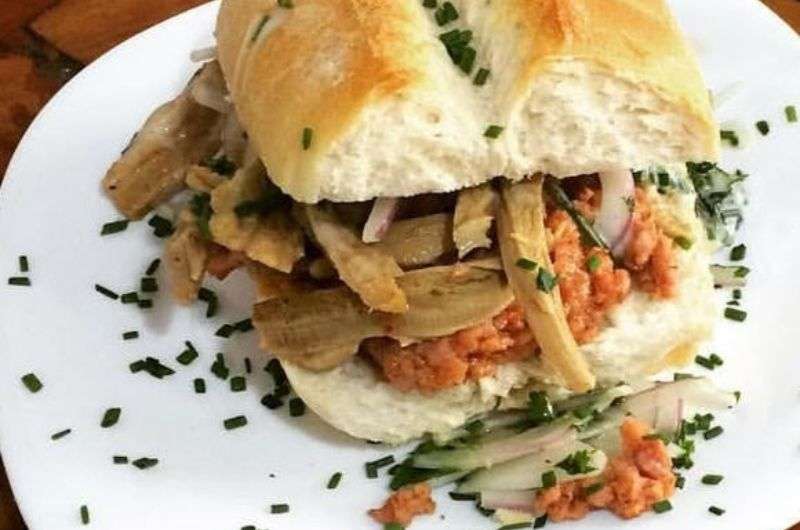
Sánguche de potito: for strong stomachs only
Alright, now we’re getting into some really weird busin-ass. No, it’s not a typo, this sandwich is made out of, ehm, a cow’s rectum.
They’re not holding back at Chilean butchers—nope, not just the usual cuts. Genitals and brains? Fair game. And if those bits don’t go to waste, why should a cow’s backside, am I right?
Let me tell you, it’s a bold move even for the brave-hearted. This Chile food is no joke—it’s a chewy, hearty sandwich snuggled inside a marraqueta bun, stacked with fried onions and meat from the cow’s rear-end, or sometimes its intestines, yummy.
So, if you’re brave enough and can get over the fact that you’re eating what you’re eating, then yeah, it’s a full-flavored adventure, let’s put it that way.
18. Ubre asada: the grill's way of milking every part of the cow
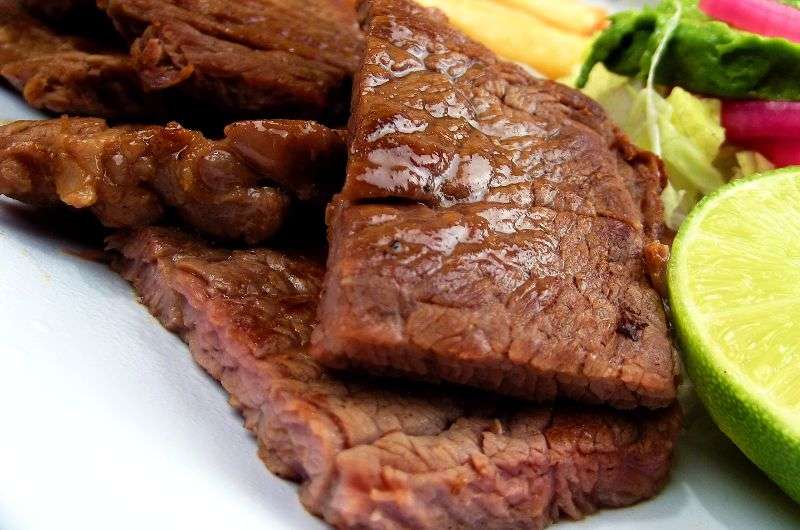
Ubre asada
If you thought that there would be anything left of a cow when Chileans got their hands on it, think again. This dish gets udderly-weird! Haha, had to get that joke out!
The key when making ubre asada is to use the freshest possible udder from a young cow, get rid of all the milk, and grill the thinly sliced udder until it gets golden brown and crispy on the edges and maintains its spongy texture in the middle.
Guys, I’m not going to overhype it, it’s strange, and it looks like burnt mittens on a plate. So, if you want to try it just for the thrill of saying you ate the weirdest Chilean cuisine, do it. Otherwise, look for something else.
International influence in Chilean food culture
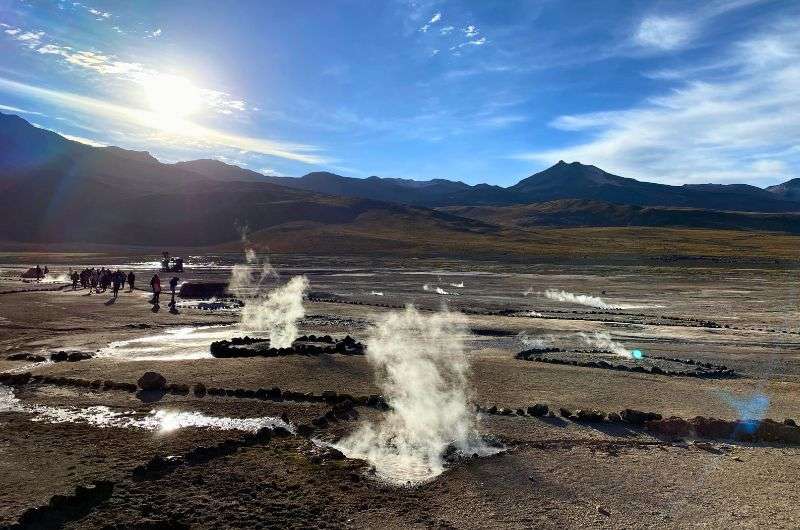
The geysers we’ve seen during our travel to Chile
I know, you might be wondering: what kind of a person would intentionally look for European food in Chile? Well, that would be me! And I promise you, you won’t regret listening to my advice.
Pro tip: Thanks to its European immigrants that brought in all kinds of influences to Chilean cuisine, Santiago is the go-to place for foodies. There is a small neighborhood called Barrio Italia, and it’s like an outdoor gallery with multiple bars and different kinds of restaurants with cuisine from all over the world.
To put it briefly, it’s a perfect social hub and a little international escape if you have a free afternoon.
19. Italian food in Chile
Just a couple blocks from Santiago’s Barrio Italia lies the best Italian restaurant I visited in Chile—Le Due Torri. Craving something different than empanadas, this restaurant saved me.
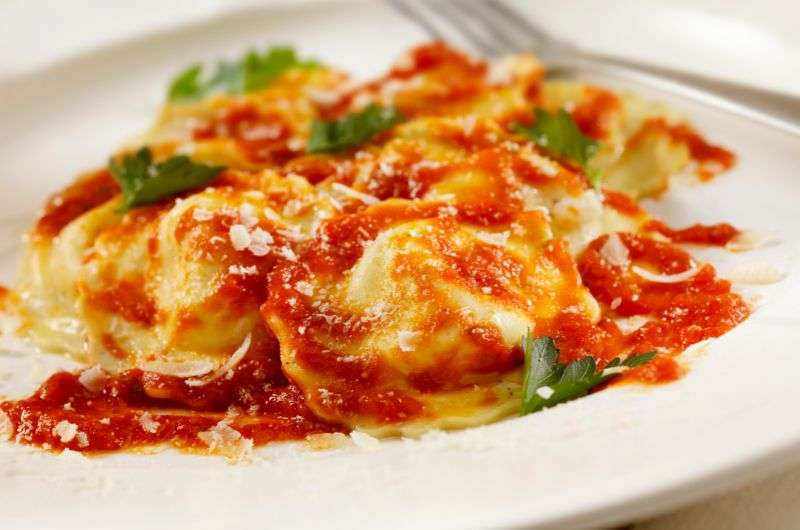
In Chicle you can get the Italian Ravioli de jaiba
Not only is their service top-notch, but they also serve delicious pasta dishes—to name a few, Try ravioli de jaiba (crab ravioli) or fettuccine salmon caviar (fettuccine with salmon and caviar) and top them off with delicious desserts—tiramisu or torta Firenze (Florentine cake).
20. German food in Chile
The second largest immigrant group that influenced Chilean cuisine, apart for the Spanish, are the Germans. I admit that it was a bit weird seeing people put sauerkraut on their hotdogs, but to be honest, it was good. Not a 5-star culinary experience, but it wasn’t bad either.
In almost every pastry shop, you can find kuchen, a German cake done in various styles that makes for a great sweet snack on the go.
For the best German food in Santiago, go to Tante Marlene, try their sausage platter, Alsatian tartare or goulash, but save some space for the beers! Oh, the beers! They have a huge selection here, so be ready to spend some time beer tasting.

In Chile you can find also the German kuchen
Chile drinks: from beer to wine and everything in between
We’ve covered the most important aspects of Chilean cuisine and its traditional dishes and culture, but what about their drinking culture? Well, Chileans like to socialize over a glass of an alcoholic drink, and they have plenty to choose from…
21. Pisco Sour: Chile’s boozy liquid sunshine
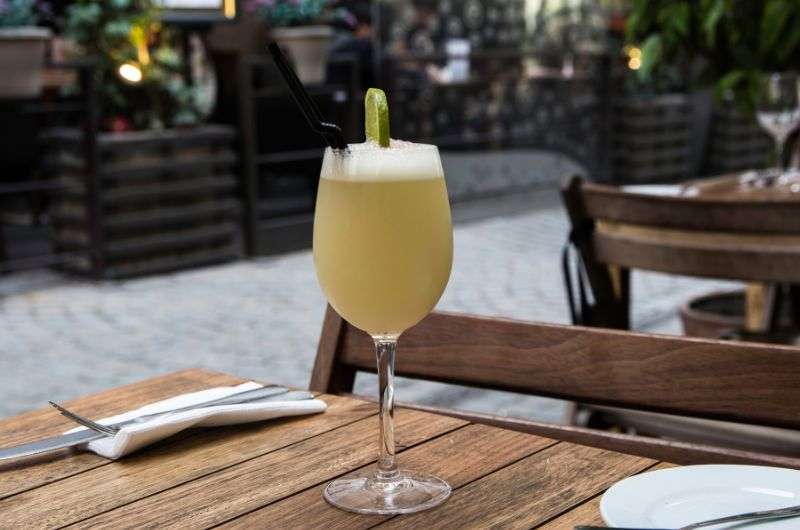
Pisco Sour
Chile’s favorite cocktail is called pisco sour, made from pisco brandy, simple syrup, lime juice, egg white, and a few drops of bitters.
Be careful though, this cocktail can start a heated debate over the origin of the pisco brandy, as it is generally accepted that it came from Peru, but Chile claims otherwise.
In the end, it doesn’t really matter who came up with pisco brandy first (to me, anyway), the pisco sour cocktail needs to be tried when you’re traveling in Chile. Or Peru.
22. Chicha: the fizzy, fruity drink with ancient vibes
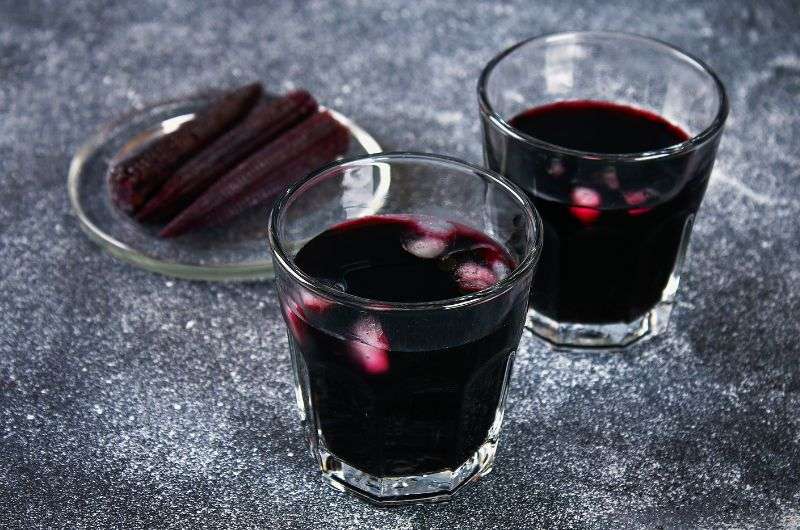
Chicha
Chicha is another must-try Chile drink. It is either a fermented grape juice, or fermented apple juice, depending on in which region in Chile you currently are.
Grape chicha is produced in central Chile and apple chicha is produced in southern regions of Chile. This drink is very popular at national celebrations like the Fiestas Patrias. It’s not super sweet or alcoholic so it’s a great option for when you’re thirsty and don’t want to get drunk super-fast.
23. Wine from Chile: Chile wine facts
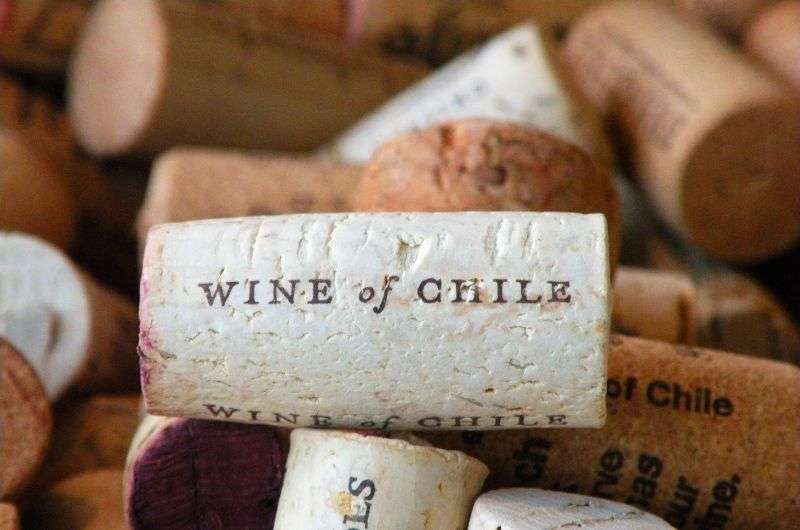
They make excellent wine in Chile
Chile is well-known for their wines, and rightfully so—their wines are amazing, and they’ve got the knack of pairing their wines with meals perfectly—it’s like their liquid pride.
They’ve been making wine since the Spanish colonization in the 16th century, they’re rocking it, and they KNOW it. I noticed that Chileans are particularly proud of their wines and wine culture.
There are so many diverse wine regions in Chile. Coastal chill vibes, warm valleys—they’ve got it all covered. Red wine? Oh yeah, their favorites are Cabernet Sauvignon, Merlot, and Carmenere which they thought was extinct. And for the white wine? Sauvignon Blanc and Chardonnay are popular Chilean wine standouts.
A big hit is wine tourism, where you can explore vineyards, sip, take tours, and even spend a night or two at the wineries. Chile is very big on sustainable farming as well, and they will proudly tell you all about it any chance they get!
24. Chilean beers: I liked!
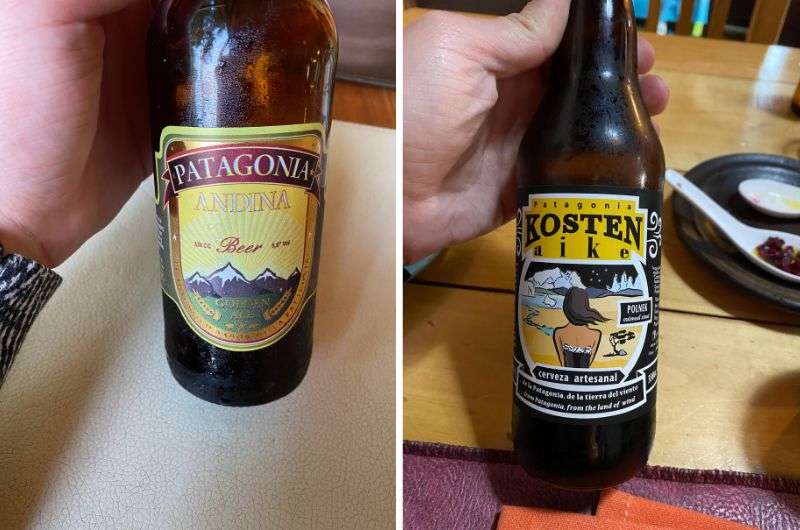
I rate the Chilean beer very positively!
Wait, it’s not only about the wines? Hell no, and for a beer lover like me, it’s great news! Chilean beer is like the cool cousin of their wines. While vino has been running the show, beer is stepping up its game.
Craft beer is having a moment in Chile’s food scene. Microbreweries are popping up on every corner, making unique and wild flavors that turn heads. The beer styles are all over the place—you get the classic stuff, funky fruit-infused brews, and those bold IPAs that hops lovers dig (me!).
It might be the German influence, but Chileans are big on throwing beer fests that celebrate local and global brews. And guess what? Beer is crashing the food scene too. Beer pairing events are a thing now. Cheers to Chile!
Sometimes, all you need to do is take the first step... I've filtered out the best hotels in Chile for you
Save it for yourself to come back to later, or share with your friends on social media!
I've already planned your ititnerary for the trip, complete with my travel tips.
You might also be interested in reading:
- 3 Weeks in Chile: The Ultimate Travel Itinerary
- The Best of Chile in 2 Weeks: Travel Itinerary
- All You Need to Know About Traveling to Chile: 15 Tips and Tricks
- 8 Highlights from my Visit to Patagonia, Chile: Hikes, Volcanos, and More
- 20 Best Day Hikes in Chile of Various Difficulties
This post contains affiliate links. I earn a small commission if you make bookings through my links, at no additional cost to you. Thank you for your support!




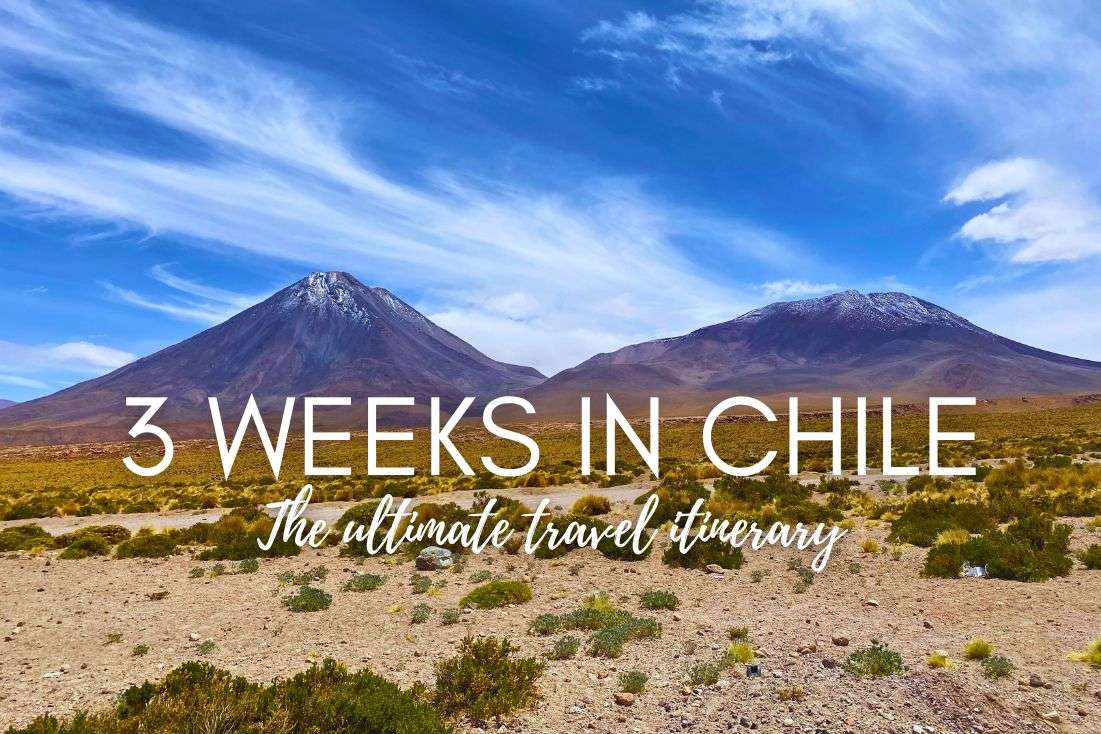





Comments | Thoughts? Give us a shout!